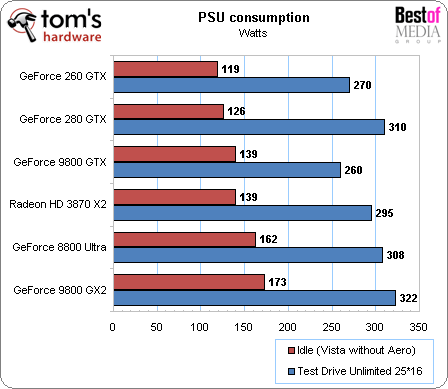Nvidia GeForce GTX 260/280 Review
Consumption
1,400 million transistors engraved at 65 µm... It augurs heavy power consumption for the card. Let’s look at the variations in consumption at the power supply (which includes the consumption of the entire configuration plus 20% in power-supply losses).

The first point is that during gameplay, the power consumption of the new cards is certainly high, but it is not record-breaking. The GTX 280 showed power use similar to that of the 8800 Ultra and less than the 9800 GX2. And if it were higher than the 3870 X2, it’s only because the card is underused in the game we tested with. As an indication, with Fillrate Tester we noted much higher consumption peaks: 404 W for the 3870X2 as against only 340 W for the GTX 280 and 279 W for the 9800 GTX. With the GTX 260, it only slightly exceeded the 9800 GTX, which is good news. As for the maximum consumption of the cards, Nvidia claims 236 W for the GTX 280 alone and 182 W for the GTX 260.
On the other hand, Nvidia’s designers have focused on at-idle power consumption. The cards have a chip that monitors the GPU use rate constantly, and using that information the driver automatically adjusts the frequency, the voltage and the activity of each part of the circuitry. And one has to admit that the GT 200s are particularly impressive, completely catching up the historical lag of Nvidia’s chips behind AMD in recent times – and then some: The GTX 260 gets credit for a 20-W drop in consumption measured at the power supply compared to the 9800 GTX, and the GTX 280 also consumes significantly less power – approximately 25 W in 2D (frequencies are dropped to 300 MHz for the GPU and 100 MHz for memory!) and approximately 35 W playing Blu-ray disks. That is really excellent, and more or less cancels the advantage of HybridPower, which requires you to change motherboards to be able to disable the 3D card completely, and lose some gaming performance in the process!
Get Tom's Hardware's best news and in-depth reviews, straight to your inbox.
-
Lunarion what a POS, the 9800gx2 is $150+ cheaper and performs just about the same. Let's hope the new ATI cards coming actually make a differenceReply -
foxhound009 woow,.... that's the new "high end" gpu????Reply
lolz.. 3870 x2 wil get cheaper... and nvidia gtx200 lies on the shelves providing space for dust........
(I really expectede mmore from this one... :/ ) -
thatguy2001 Pretty disappointing. And here I was thinking that the gtx 280 was supposed to put the 9800gx2 to shame. Not too good.Reply -
cappster Both cards are priced out of my price range. Mainstream decently priced cards sell better than the extreme high priced cards. I think Nvidia is going to lose this round of "next gen" cards and price to performance ratio to ATI. I am a fan of whichever company will provide a nice performing card at a decent price (sub 300 dollars).Reply -
njalterio Very disappointing, and I had to laugh when they compared the prices for the GTX 260 and the GTX 280, $450 and $600, calling the GTX 260 "nearly half the price" of the GTX 280. Way to fail at math. lol.Reply -
NarwhaleAu It is going to get owned by the 4870x2. In some cases the 3870x2 was quicker - not many, but we are talking 640 shaders total vs. 1600 total for the 4870x2.Reply -
MooseMuffin Loud, power hungry, expensive and not a huge performance improvement. Nice job nvidia.Reply -
compy386 This should be great news for AMD. The 4870 is rumored to come in at 40% above the 9800GTX so that would put it at about the 260GTX range. At $300 it would be a much better value. Plus AMD was expecting to price it in the $200s so even if it hits low, AMD can lower the price and make some money.Reply -
vochtige i think i'll get a 8800ultra. i'll be safe for the next 5 generations of nvidia! try harder nv crewReply